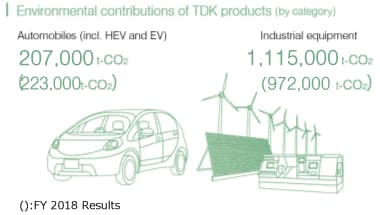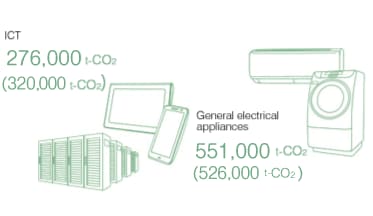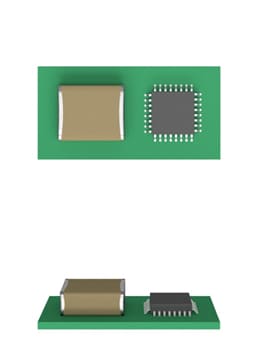Expand Environmental Contribution of Products
Background of Goals
In 1997 TDK introduced product assessment to evaluate the environmental impact of products throughout their whole lifecycle. Only products that receive certification in this product assessment screening are commercialized and distributed in the market. Furthermore, as a measure designed to continuously create products with high environment-conscious effects, in 2008 TDK introduced a system whereby products that are deemed on the basis of the product assessment results to be excellent environment-considerate products are designated as ECO LOVE products. TDK discloses information about these ECO LOVE products on its website. Its target was for such products to account for 30% of sales in FY March 2011, double the figure of 15% in FY March 2009.* By achieving this target, TDK promoted the creation and diffusion of products contributing to a reduction of the environmental load.
In addition to these existing activities, TDK focuses on the contribution of products and know-how to the reduction of CO2 emissions in society. TDK is in the process of establishing computing criteria for quantifying this environmental contribution in FY March 2011, and in FY March 2015, we formulated a set of guidelines for calculation of product contributions that reflect the results of our compilation efforts. By means of continued product assessment activities, we are aiming to promote the reduction of CO2 emissions through products.
*Sales ratio excluding head and battery products
FY March 2018 Goals and Achievements
Goal
- Improve product-based CO2 reduction contributions basic-unit by 2.7% compared with the previous FY
Achievement
- Worsened by 3.1% compared with the previous FY
Main activities and measures
- Calculate amounts of product contributions of new products
- Integrate the guidelines for contribution amount calculation intonew products assessment system
Product-based CO2 reduction contributions in FY March 2018 amounted to 2.149 million tons, up 5.2% from the previous FY, and CO2 reduction contributions basic-unit worsened by 3.1% compared with the previous FY. Thus, our goal was not achieved
Trend in the reduction of CO2 emissions through products*1,2
- *1 A third party review of the calculation method was performed
- *2 TDK calculates product contributions based on in-house guidelines conforming with the “TR62716 Guidance on quantifying greenhouse gas emission reductions from the baseline for electrical and electronic products and systems” of the International Electrotechnical Commission (IEC), the “Guidelines for the Calculation of Contributions to the Reduction of Greenhouse Gas Emissions” of the Institute of Life Cycle Assessment, Japan, and the “Guidance on the GHG Emission Reduction Contributions of Electronic Products” of the Japan Electronics and Information Technology Industries Association (JEITA).
Future Activities
We will strive to develop environment-contribution products that contribute to reducing impact on the environments of customers and society and will expand the spread of our products by emphasizing their value.
Concrete Activities
Automotive MLCCs contribute to reducing environmental load
TDK has miniaturized and increased the capacity of multilayer ceramic chip capacitors (MLCCs) through adoption of ultra-fine structures made possible by advanced materials technologies and advanced layering technologies that enable the production of 1,000 layers. As a result, MLCCs are used many common products such as automobiles, consumer electronics, and information and communications devices.
As a result of miniaturization of products used in automobiles, the environmental contribution of MLCCs is equal to 19,162 tons when converted to CO2. We expect that this contribution will increase even further as environmentally friendly vehicles are used more widely.





